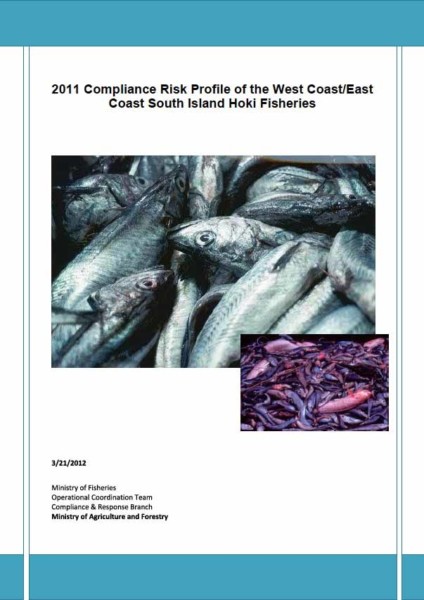 The leaked ‘2011 Compliance Risk Profile of the West Coast/East Coast South Island Hoki Fisheries’ report was produced by the compliance division of the Ministry of Fisheries in 2012, and reveals widespread fish dumping and under-reporting in the deepwater hoki fishery in New Zealand.
The leaked ‘2011 Compliance Risk Profile of the West Coast/East Coast South Island Hoki Fisheries’ report was produced by the compliance division of the Ministry of Fisheries in 2012, and reveals widespread fish dumping and under-reporting in the deepwater hoki fishery in New Zealand.
Hoki Compliance Risk Profile Report (PDF)
MPI_OIA_Release_Operation-Bronto-Summary (PDF)
The report was based on three operations carried out by the investigations team at Ministry of Fisheries: Operation Mini (2004), Operation Maxi (2005) and Operation Bronto (2011). All three operations found broadly similar results. Operation Bronto was the biggest of the three and involved the use of New Zealand naval vessels to board fishing vessels at sea as well as intercepting fishing vessels as they landed their catch and other investigatory techniques.
Key findings include:
- Talleys were operating a system of weighing cartons of fish that could result in 780 tonnes of hoki being under-reported in a single season [p.34]. The Fisheries Officers believed that this system was unlawful and Talleys should be directed to stop this practice [p.89].
- The report found that a Sanford manager removed a computer that recorded daily catch and processing records from a vessel before Fisheries Officers could examine it, compromising the inspection [p.22].
- Large discrepancies between the carton weights checked by Fisheries officers versus those reported by fishing companies meant that around 280 tonnes of hoki was not reported in monthly returns. Of the under-reported hoki, 90 tonnes was by Sanford, Amaltal under-reported 59 tonnes, and Independent 49 tonnes [p.40].
- The official mandatory estimated catch forms were routinely filled out after the catch was processed, so there was ample opportunity to misreport the original catch [p.20].
- NZ and Ukrainian vessels were not completing daily onboard processing forms according to Govt guidelines so it was very difficult for Fisheries Officers to reconcile catch records against processing records [p.21].
- For those ships that turn whole fish into filleted fish at sea, the conversion factor used by fishing companies to convert weight of processed fillets into weight of fish caught (and hence quota needed) resulted in two Sanford vessels under-reporting catch of up to 343 tonnes of hoki and three Amaltal vessels under-reporting 592 tonnes [p.49].
- When observing actual filleting process on one Amaltal vessel, Fisheries Officers found that conversion factors were wrong resulting in 9% underreporting of fish caught [p.48].
- Vessels with mealing machines reported less whole Hoki when there were no observers on board. There was probably around 2000 tonnes of under-reported whole hoki, which was turned into fish meal [p.63].
- Based on the length of fish reported versus length of fish expected, there was 1541 tonnes of small fish illegally dumped in the West Coast hoki fishery [p.61].
- There was a large amount of dumping of ling, as revealed by too many heads for the number of bodies [p.66].
There was evidence of misreporting of both quota and non quota species [p.66]. Expected catch of 1221t of Hake but only reported 500t or about 43% of expected catch was reported [p.67]. Reporting of shark catch is chaotic [p.69]. Scabbardfish was probably being used fraudulently to cover the mealing or discarding of frostfish [p.70]. Rose dory and Silver dory were probably being used fraudulently to cover the mealing or discarding of lookdown dory [p.70]. Eel bycatch was hardly reported at all [p.70]. - In the East Coast hoki fishery, they were supposed to avoid Hoki Management Areas where there were large numbers of juvenile hoki but instead were targeting them and saying they were after other species. One observer’s report about Sanford’s San Discovery: “In the observers opinion the vessel was misreporting the target species in order to circumvent the [rules] in order to target juvenile hoki. This practice is widespread throughout the domestic and foreign charter fleet” [p.82]
- “Vessels are consistently fishing areas where small hoki cannot be avoided; Some vessels are not landing as much hoki as could be expected; significant quantities of small hoki are being illegally discarded” [p.86].
